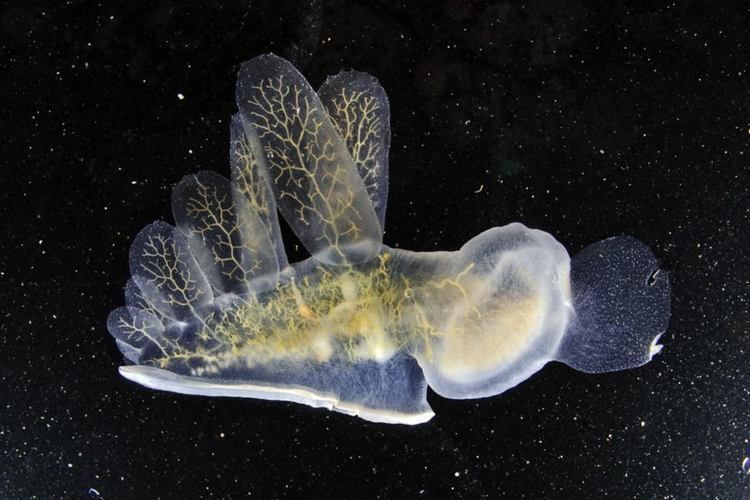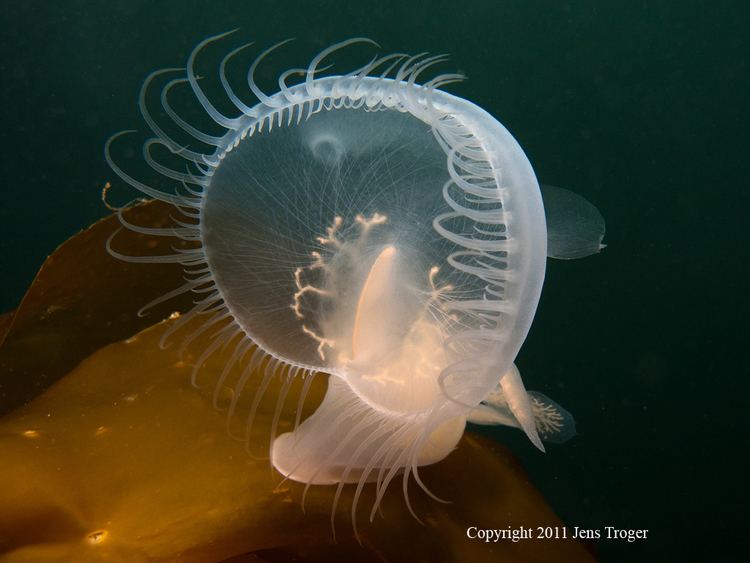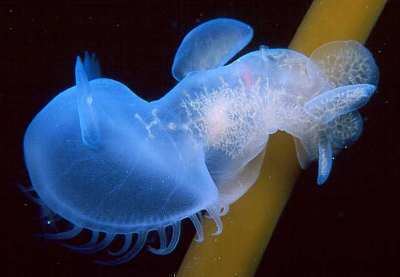Higher classification Melibe | Scientific name Melibe leonina Rank Species | |
 | ||
Similar Melibe, Nudibranch, Molluscs, Gastropods, Dirona | ||
Hooded nudibranch melibe leonina
Melibe leonina, common names the "hooded nudibranch", "lion's mane nudibranch", or "lion's mane sea slug" is a species of predatory sea slug, specifically a nudibranch, a marine gastropod mollusk in the family Tethydidae.
Contents
- Hooded nudibranch melibe leonina
- Melibe leonina feeding at the oregon coast aquarium
- Distribution
- Description
- Habitat
- Feeding habits
- Life cycle
- Predators
- References

Melibe leonina feeding at the oregon coast aquarium
Distribution
This species occurs on the west coast of North America, from Alaska to Baja California.
Description
This nudibranch is up to 102 mm long, 25 mm wide, and 51 mm across the expanded oral hood.

The body of this nudibranch is translucent. It is usually colorless to pale yellow or green, with opaque brown hepatic diverticula. It has a large expandable oral hood, fringed with sensory tentacles, which it opens and throws forward in order to catch food. A single pair of rhinophores on the hood are rounded and earlike. 4-6 pairs of flat paddle shaped cerata run along its dorsum in two rows.

Melibe leonina exudes a sweet fruity aroma when it is removed from the water, or when numerous individuals are kept together in captivity. Because of their smell and the way they expand their oral hoods while attached to kelp and eelgrass, a group of Melibe is called a "bouquet".
Habitat
Found on eelgrass and other seaweeds near low tide and below, and in kelp forest in deeper water.
Feeding habits

Melibe leonina is carnivorous and hunts for food, while attached to grasses, by extending its oral hood out and downward like a net. When the ventral surface of the hood contacts a small animal, the hood rapidly closes and the fringing tentacles overlap, holding in the prey then forcing the whole animal into the mouth. Prey include amphipods, copepods, mysids, other small crustaceans, small mollusks, small jellyfish and ctenophores, larvae of other invertebrates and in some cases small fish.
Life cycle

Like most other sea slugs, Melibe leonina is a hermaphrodite. They apparently live about one year, reciprocally fertilize one another, lay their eggs and die. Eggs are attached to kelp and eelgrass in long, wide yellow or cream-colored ribbons which form tight coils or wavy folds.
Predators
Predators may include fish, kelp dwelling crabs and sea stars, but when disturbed Melibe leonina has the ability to autotomize (shed) its cerata. This may distract an attacker as the discarded appendages float off, enabling the sea slug to escape.
When harassed or dislodged, Melibe leonina is capable of swimming. It uses rhythmic lateral-bending movements, and can sometime travel long distances across open water. The upside-down, side-to-side thrashing motion involves complex movements which have been extensively studied.
